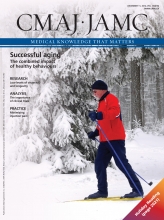Aging successfully
We all know that living well leads to a better life, but the Whitehall II study reveals how good it can be. This high-quality cohort study shows that each of the following behaviours adds in a measurable and independent way to survival free from major health problems: regular physical activity, daily fruit and vegetable consumption, not smoking and consuming alcohol moderately. Practitioners now have good evidence to counsel their patients on how to live longer. See Research, page 1985

Image courtesy of © 2012 Thinkstock
Most of us would like to live longer if we can be healthy enough to enjoy the extra time. The four behaviours mentioned above may increase the odds of living in good health beyond 60 years of age. The future may yield additional insights, as genomic, epigenomic, proteomic and metabolomic studies are just beginning to assess components of healthy aging. See Commentary, page 1973
Low vitamin D may not be so bad

Image courtesy of © 2012 Thinkstock
Adults whose parents lived into very old age have lower blood levels of vitamin D than comparable adults. This analysis comes from the Leiden Longevity Study, which compared the offspring of nonagenarians to their own partners. The authors suggest that this finding casts doubt on the possibility that the previously observed association between low blood levels of vitamin D and increased mortality is causal. See Research, page E963
ER wait times and mental illness
Patients visiting the emergency department for reasons related to mental illness waited less time to be seen by a physician than other patients when the emergency department was crowded and only slightly longer than other patients when it was not crowded. This observational study analyzed population-based health services data from Ontario for over 8 million visits to 155 emergency departments between 2007 and 2009. The results allay concerns that emergency departments have not been triaging patients with mental illness appropriately, say the authors. See Research, page E969
Mother–infant ICU admissions
Mother–infant pairs in which both were admitted to intensive care units (ICUs) following delivery had the highest prevalence of separation due to interfacility transfer. In this study of routinely collected data, these mothers and babies also had the highest mortality compared with groups in which only the mother or the baby was admitted to an ICU. Coordination and communication of care plans could lessen the burden and frequency of separation of mother and newborn seen with concurrent ICU admissions, suggest the authors. See Research, page E956
Boost RCTs in Canada
Randomized controlled trials (RCTs) in Canada receive a disproportionately low level of funding compared with other forms of research. According to Yusuf and Cairns, RCTs are important to the health of Canadians and the health care system. They argue that the Canadian Institutes of Health Research should increase funding for RCTs from 3.3% to 10% within 5 years. There also needs to be an appropriate infrastructure, an increase in partnerships, and strategies to overcome regulatory and institutional barriers to performing RCTs. See Analysis, page 1997
Minimizing anesthetic injection pain

Image supplied by author
Strazer and Lalonde outline 5 practical tips for reducing the likelihood of pain for patients during injection of local anesthetic. These include choice of needle, temperature of the solution, use of a buffer and injection techniques. See Practice, page 2016
Holiday reading

Image courtesy of © 2012 Thinkstock
Humorous missives on the Mayan doomsday effect, an alarmingly green patient, how fake doctors use technology and the nebulous world of facts; plus reflections on the resuscitation of a medical marriage, a gift that transcends language and the giving of gratitude. CMAJ joyfully shares these treats this holiday season. See Holiday Reading, page 2021











